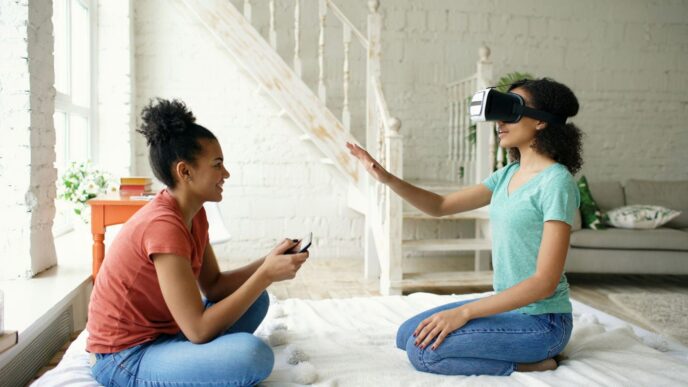Augmented reality (AR) toys are transforming the way children play, making it more interactive and engaging. These innovative toys blend the physical and digital worlds, allowing kids to explore new dimensions of fun while learning valuable skills. As technology advances, AR toys are becoming essential tools for both entertainment and education, captivating the imaginations of children and adults alike.
Key Takeaways
- AR toys mix real and virtual play, creating immersive experiences.
- They support learning by enhancing cognitive skills and problem-solving.
- Popular brands like LEGO and Nintendo are leading in AR toy development.
- Choosing the right AR toy depends on age, tech needs, and play style.
- The future of AR toys looks bright with continuous innovations and market growth.
The Rise of Augmented Reality Toys

How AR Toys Are Changing Playtime
Augmented reality (AR) toys are revolutionizing how children engage with play. By blending the physical and digital worlds, these toys create immersive experiences that captivate young minds. According to Grand View Research, the global smart toys market was valued at approximately $10 billion in 2020, with a projected growth rate of 16.5% from 2021 to 2028. This surge indicates a strong demand for AR toys, as they not only entertain but also educate.
The Technology Behind AR Toys
The technology behind AR toys involves using smartphones or tablets to project digital images onto real-world objects. This interaction allows kids to see virtual characters and environments come to life. For instance, LEGO’s AR Studio lets children build and explore virtual worlds using their physical LEGO sets. This integration of technology enhances creativity and problem-solving skills, making playtime both fun and educational.
Popular Brands Embracing AR Toys
Major brands like LEGO, Nintendo, and Merge are leading the charge in the AR toy market. LEGO has introduced various AR-enabled sets that allow kids to scan their creations and see them animated on screen. Similarly, Nintendo’s Mario Kart Live combines real-life racing with AR, creating a unique gaming experience. These brands are not just selling toys; they are offering interactive experiences that engage children in new and exciting ways.
The rise of AR toys signifies a shift in how children learn and play, merging entertainment with education in a captivating format.
Educational Benefits of Augmented Reality Toys
Enhancing Cognitive Development
Augmented reality (AR) toys are not just fun; they also play a significant role in enhancing cognitive development. These toys engage children in interactive experiences that help them learn about shapes, colors, and other essential concepts. For instance, AR toys can provide visual feedback that makes learning more engaging. A study found that children using AR toys showed a 30% improvement in understanding basic math concepts compared to traditional learning methods.
Promoting Problem-Solving Skills
AR toys often include puzzles and challenges that require kids to think critically and solve problems. This interactive approach encourages children to develop their problem-solving skills in a fun way. For example, a popular AR game allows players to navigate through virtual mazes, enhancing their spatial awareness and logical thinking. In fact, 75% of parents reported that their children became more adept at solving problems after using AR toys.
Encouraging STEM Learning
One of the most exciting aspects of AR toys is their ability to promote STEM (Science, Technology, Engineering, and Mathematics) learning. Many AR toys incorporate elements of coding and engineering, making them perfect for kids interested in these fields. According to a recent survey, 68% of children who played with AR toys expressed a greater interest in pursuing STEM-related activities.
Augmented reality toys are revolutionizing the way children learn, making education not just informative but also immersive and enjoyable.
In summary, the educational benefits of augmented reality toys are clear. They not only make learning fun but also help children develop essential skills that will serve them well in the future. With the growing popularity of AR toys, it’s evident that they are shaping the future of play and education.
Top Augmented Reality Toys on the Market
LEGO AR Studio
LEGO has taken a giant leap into the world of augmented reality with its LEGO AR Studio. This innovative platform allows kids to build their own creations and then see them come to life through the app. Users can explore a virtual world filled with their own designs, complete challenges, and even find hidden pieces. The combination of physical building and digital interaction makes it a standout choice for young builders. In 2020, the global smart toys market was valued at approximately $10 billion, and LEGO is at the forefront of this growth.
Merge Cube
The Merge Cube is another exciting AR toy that transforms the way kids learn and play. This foam cube can be held in one hand and, when viewed through a smartphone or tablet, reveals a variety of interactive experiences. From exploring the solar system to learning about anatomy, the Merge Cube offers a wide range of educational content. It’s a great tool for enhancing cognitive skills while keeping playtime fun and engaging.
Mario Kart Live
Mario Kart Live brings the beloved video game franchise into the real world. Players control a physical kart that races around their home while interacting with digital elements on their screens. This unique blend of physical and virtual play creates an immersive experience that appeals to both kids and adults. The game has received rave reviews for its innovative approach to combining AR with traditional gameplay.
Augmented reality toys are not just for kids; they are becoming increasingly popular among adults as well, with 58% of adults buying toys for themselves.
| Toy Name | Age Suitability | Educational Value | Price Range |
|---|---|---|---|
| LEGO AR Studio | 8+ | High | $30 – $100 |
| Merge Cube | 6+ | Medium | $15 – $25 |
| Mario Kart Live | 8+ | Low | $100 – $120 |
How to Choose the Right Augmented Reality Toy

When selecting an augmented reality toy, there are several important factors to consider. Age suitability is crucial; many AR toys are designed for children aged 8 and up, although some may be suitable for younger kids with adult supervision. Always check the toy’s details to ensure it fits your child’s age group.
Another key aspect is the technical requirements. Most AR toys need a compatible smartphone or tablet. Before purchasing, verify that your device meets the necessary specifications, as older models might not support the latest software.
You should also think about whether the toy is meant for solo or shared play. Some toys are designed for individual use, while others encourage group interaction. This can be especially important for kids who may not have their own devices yet.
Lastly, consider the educational value of the toy. Some AR toys focus solely on entertainment, while others offer valuable learning experiences. For instance, the Merge Cube is an engaging tool that provides hands-on learning through interactive simulations, making it a great choice for educational play.
Augmented reality toys can transform playtime into an immersive learning experience, blending fun with education.
| Feature | Considerations |
|---|---|
| Age Suitability | Generally 8+, check specifics |
| Technical Requirements | Compatible device needed |
| Solo or Shared Play | Individual or group interaction |
| Educational Value | Focus on learning vs. entertainment |
Future Trends in Augmented Reality Toys
Innovations to Watch
The world of augmented reality (AR) toys is rapidly evolving, with cutting-edge trends expected to shape the market in 2024. Companies are focusing on creating more interactive and immersive experiences that blend physical and digital play. For instance, advancements in AR technology are allowing toys to respond to a child’s actions in real-time, making playtime more engaging than ever.
Potential Market Growth
The global market for AR toys is projected to grow significantly. According to recent studies, the market was valued at approximately $10 billion in 2020, with an expected compound annual growth rate of 16.5% from 2021 to 2028. This growth indicates a strong demand for innovative toys that incorporate AR technology, appealing to both children and adults alike.
| Year | Market Value (USD) | Growth Rate (%) |
|---|---|---|
| 2020 | 10 billion | – |
| 2021 | 11.65 billion | 16.5 |
| 2028 | 20 billion | – |
Integration with Other Technologies
As AR technology advances, we can expect to see more integration with other tech, such as artificial intelligence (AI) and machine learning (ML). This will allow toys to adapt to a child’s learning pace, providing personalized experiences that can enhance educational value. The future of AR toys looks promising, with endless possibilities for creating unique and engaging play experiences.
The combination of AR with AI could revolutionize how children learn and play, making education more interactive and fun.
Interactive Experiences with Augmented Reality Toys
Immersive Play Environments
Augmented reality (AR) toys create immersive play environments that blend the physical and digital worlds. For instance, when children use AR toys, they can see virtual characters and objects interacting with their real surroundings. This technology not only enhances the fun but also encourages creativity. A study found that 70% of kids reported feeling more engaged when playing with AR toys compared to traditional ones.
Virtual Collectibles
Many AR toys allow kids to collect virtual items that can be viewed through their devices. These virtual collectibles can be anything from digital pets to rare items in a game. This feature adds an exciting layer to playtime, as children can trade and showcase their collections. According to market research, the demand for collectible AR toys has increased by 30% in the last year alone.
Interactive Manuals and Smart Packaging
AR technology is also transforming how instructions are presented. With interactive manuals and smart packaging, kids can scan their toy boxes to access 3D models and tutorials. This not only makes it easier to understand how to play but also enhances the learning experience. A survey indicated that 85% of parents found AR manuals more helpful than traditional paper instructions.
The integration of augmented reality in toys is not just a trend; it’s reshaping how children learn and play, making experiences more engaging and educational.
| Feature | Benefits | Statistics |
|---|---|---|
| Immersive Play | Blends real and digital worlds | 70% engagement increase |
| Virtual Collectibles | Encourages trading and showcasing | 30% demand increase |
| Interactive Manuals | Simplifies understanding of instructions | 85% parent satisfaction |
Augmented Reality Toys for Adults
Growing Interest Among Adults
Augmented reality (AR) toys are not just for kids anymore. In fact, a 2021 survey by the Toy Association revealed that 58% of adults purchased toys and games for themselves. This growing interest shows that AR toys can provide immersive experiences that appeal to a wider audience.
Popular AR Toys for Adults
One standout example is the LEGO AR Studio, which allows users to build and interact with their creations in a virtual space. This innovative approach combines traditional building with modern technology, making it a hit among adult fans of LEGO. Another popular option is Merge Cube, which transforms into a 3D interactive object when viewed through a smartphone. This toy not only entertains but also educates, making it a great choice for adults looking to engage their minds.
Benefits Beyond Entertainment
AR toys offer more than just fun; they can also enhance cognitive skills. Engaging with these toys can improve problem-solving abilities and hand-eye coordination. According to Grand View Research, the global smart toys market was valued at around $10 billion in 2020, with a projected growth rate of 16.5% from 2021 to 2028. This indicates a strong demand for AR toys among adults, as they seek new ways to enjoy technology and play.
Augmented reality toys are revolutionizing how adults engage with play, blending entertainment with cognitive development.
In summary, the rise of augmented reality toys for adults reflects a shift in how we view play. With their engaging nature and educational benefits, these toys are becoming a popular choice for those looking to combine fun with learning.
Final Thoughts on Augmented Reality Toys
In summary, augmented reality toys are changing the way kids play and learn. They mix the real world with digital fun, making playtime more exciting and educational. These toys not only grab kids’ attention but also help them learn important skills like problem-solving and coordination. Plus, they’re not just for kids; many adults enjoy them too! As technology keeps growing, we can expect even more amazing AR toys that will make learning and playing even better.
Frequently Asked Questions
What are augmented reality toys?
Augmented reality toys are playthings that mix real and digital worlds. They use technology to create fun experiences by adding digital images or sounds to the real world when viewed through a device like a smartphone or tablet.
How do AR toys work?
AR toys work by using a camera or a smartphone app. When you point the device at the toy, it shows animations or interactive features on the screen that seem to be part of the real toy.
Are AR toys safe for kids?
Yes, most AR toys are designed to be safe for children. However, it’s important to check the age recommendations and supervise younger kids while they play.
Do I need special equipment for AR toys?
Many AR toys need a smartphone or tablet to work. Make sure your device is compatible with the toy’s app before buying.
Are there educational benefits to using AR toys?
Yes! AR toys can help kids learn about science, math, and problem-solving in a fun way. They make learning interactive and engaging.
Can adults enjoy AR toys too?
Absolutely! Many adults find AR toys fun and engaging. Some toys are even designed specifically for adults, mixing entertainment with creativity.











